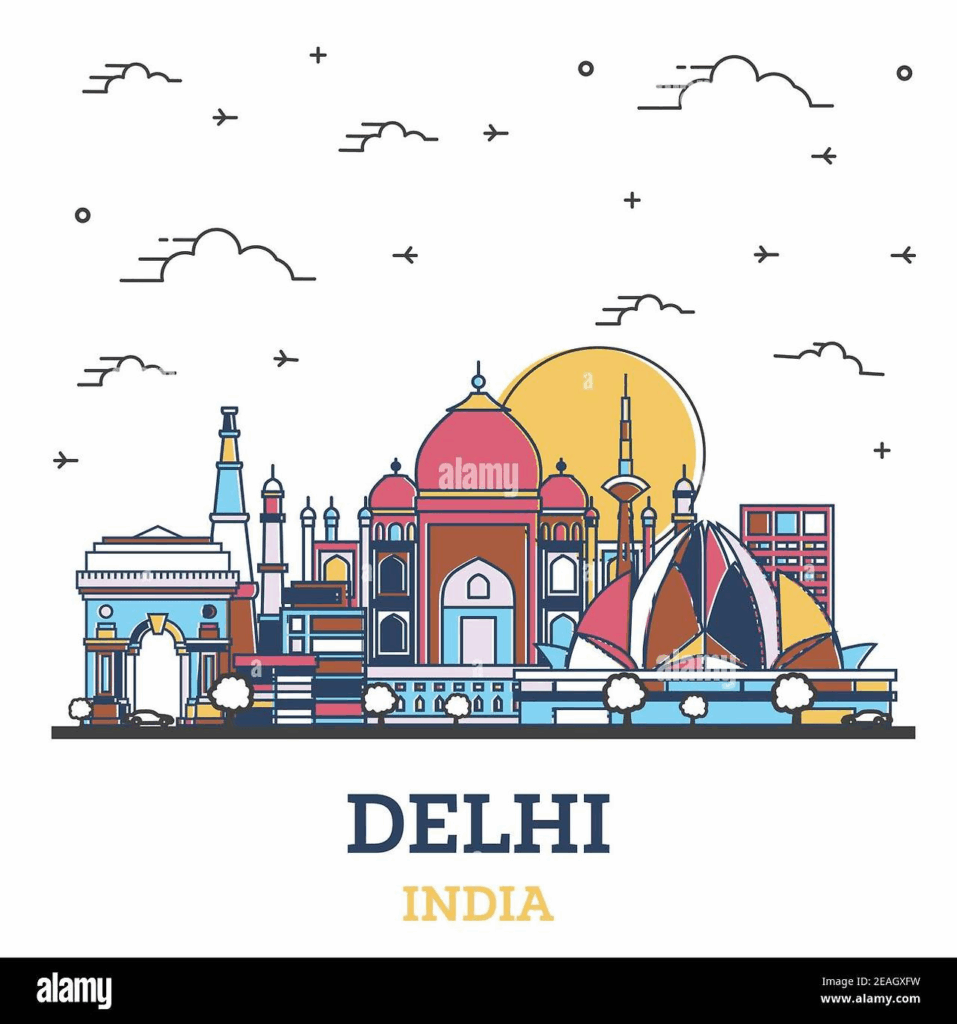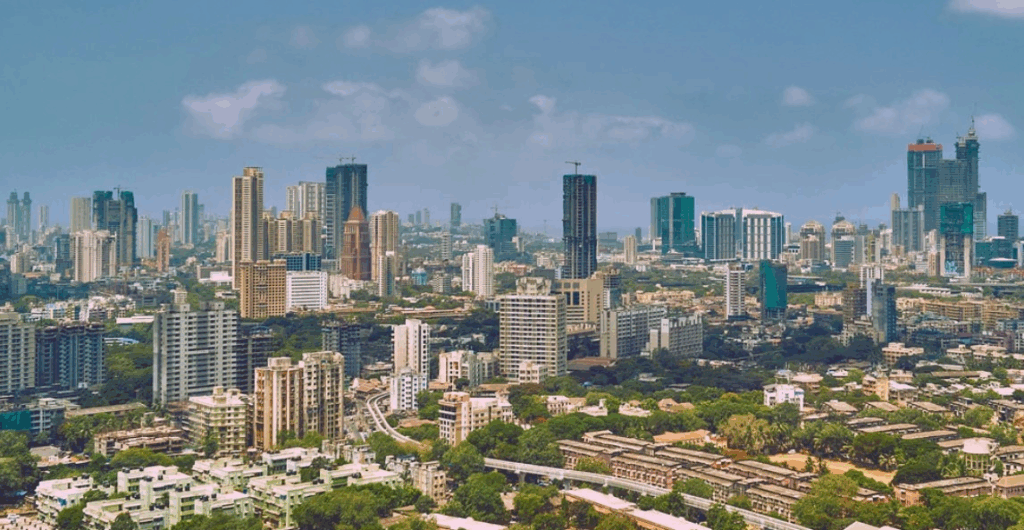Here’s the blog post about Delhi, translated into English and formatted for a blog:
Delhi: A Megacity Where Ancient Roots Meet Modern Challenges
Delhi, the vibrant capital of India, stands as one of the world’s largest megacities, a sprawling metropolis where diverse cultures, religions, languages, and environments coexist. It’s a city of immense historical depth, economic dynamism, and significant urban challenges.

1. City Overview
Population:
- NCT Delhi (Administrative Area): Approximately 16.78 million (estimated 2025).
- Metropolitan Area (NCR): Around 33.66 million, comparable to Tokyo, projected to reach 34.70 million in 2025 with an annual growth rate of 2.54%.
Area:
- NCT Delhi: 1,483 km² (estimated, including NCT + Central NCR).
- Greater NCR: Approximately 2,344 km².
Climate: Delhi experiences an extreme continental climate with distinct dry and wet seasons. Winter often brings dense smog and fog.
Languages:
- Official Languages: Hindi, Urdu, English.
- Commonly Spoken: Hindi (approx. 81%), Punjabi (approx. 7%), Urdu (approx. 6%), Bengali, and other languages (approx. 5%).
Religion:
- Hinduism: 81–82%
- Islam: 12–13%
- Sikhism: 3–4%
- Jainism: 1%
- Christianity, Buddhism, and others also present.
Literacy Rate: Delhi boasts an impressive average literacy rate of 86–87% (91–92% for males, 80–83% for females), with an illiteracy rate of about 13%.
Sex Ratio: Approximately 866–876 females per 1000 males. (Source: en.wikipedia.org)
2. History 🕰️
Ancient to Medieval (Pre-1526 AD):
- Indraprastha: Featured in the ancient epic Mahabharata, suggesting early origins.
- Post-1192 Muslim Invasions: The Delhi Sultanate emerged, making Delhi a key center of power.
Mughal Era (1526–1803):
- Babur founded the Mughal Empire in 1526.
- Shah Jahan established ‘Shahjahanabad’ in 1638 (now Old Delhi / Purani Dilli), completing iconic structures like Jama Masjid and the Red Fort. Delhi solidified its role as a vital center for various Sultanate and Mughal dynasties.
Colonial Period (1803–1947):
- British Occupation (1803): Elevated Delhi’s status as a cultural and administrative hub.
- First Major Uprising (1857): Followed by more direct British control.
- Capital Shift (1911): The imperial capital moved from Calcutta to Delhi, with New Delhi officially completed in 1931 (designed by Lutyens).
Post-Independence (1947–Present):
- Indian Independence (1947): New Delhi remained the official capital and subsequently experienced rapid growth and metropolitan expansion.
- Recent Developments: Continued NCR expansion, heightened political and social dynamics leading up to the 2025 general elections, and the challenges of congestion and air pollution due to rapid population growth.
- 2025 Legislative Elections: BJP’s expected return to power.

3. Geography
Location & Topography:
- Located in north-central India, at the southern tip of the Punjab Plains, along the Yamuna River, and within the Indo-Gangetic Plain.
- Delhi Ridge: An extension of the Aravalli mountain range, acting as a vital green belt (approx. 35km long) that offers protection to the city.
Administrative & Urban Structure:
- Old Delhi: Centered around Mughal-era monuments, including Shahjahanabad.
- New Delhi: A meticulously planned city reflecting British colonial influence, serving as the administrative heart.
- NCT Delhi & Greater NCR: Includes numerous satellite cities like Gurugram, Noida, Dwarka, and Faridabad, which contribute to the vast metropolitan area. (Sources: en.wikipedia.org, tribuneindia.com)

4. Culture
Linguistic & Religious Diversity:
- A rich mix of Hindi, Urdu, Punjabi, and English, fostering a diverse cultural and musical landscape.
- The coexistence of Hinduism, Islam, Sikhism, Jainism, and Christianity makes Delhi a city of numerous vibrant temples, mosques, gurudwaras, and other places of worship, truly a sacred urban center.
Cultural Heritage & Festivals:
- Both Old and New Delhi are home to numerous temples, mosques, churches, and gurudwaras (e.g., Raj Ghat, Rashtrapati Bhavan).
- Major festivals like Diwali, Eid al-Fitr (end of Ramadan), Guru Nanak Jayanti, and Christmas are celebrated with great fervor, reflecting the city’s multicultural harmony.
- Modern Lifestyle: Areas like Hauz Khas and Lodhi Gardens are popular among the youth, serving as hubs for fusion cuisine and contemporary social life.
- The city is alive with film festivals, book fairs, religious celebrations, and a wealth of cultural events.
5. Environment
Natural Green Spaces & Ecosystems:
- Delhi Ridge: Often referred to as the “green lungs of the city,” it’s also a significant bird habitat.
Environmental Challenges & Responses:
- Urban Heat Island Effect, Traffic Congestion, Air Pollution & Smog: Delhi faces severe air quality issues, especially during winter, with AQI levels sometimes exceeding 1700. (Source: news.com.au)
- Slum Overcrowding & Poverty: Approximately 49% of NCT Delhi’s population resides in slums, a situation exacerbated when considering the wider NCR. (Sources: en.wikipedia.org, en.wikipedia-on-ipfs.org)
Eco-Friendly Projects:
- Delhi Metro: Holds ISO 14001 certification and has implemented solar power and rainwater harvesting systems.
- Increased Use of Delhi Metro and Autorickshaws: Promoting sustainable public transport.
- Public Mask Campaigns, School Closures, and AQI Early Warning Systems: Measures implemented to combat severe air pollution.
6. Economy
Industrial Structure:
- Core Functions: A major administrative and political hub (government, education, diplomacy), and a thriving center for service, education, and legal industries. IT, finance, tourism, and education sectors are highly active.
- Commercial Districts: Well-developed commercial areas like Connaught Place serve as key business centers.
- Neighboring Industries: Gurugram and Noida are concentrated with IT and manufacturing, forming a mega-economic region within the NCR.
- Residential & Transportation Infrastructure: New townships like Dwarka and Gurugram, alongside an expanding metro network, support urban growth.
- Relocation Discussions: Due to extreme pollution and infrastructure overload, discussions about potentially relocating the capital have arisen.
Economic Indicators:
- NCT GDP: ₹3.1 trillion Rupees (2011–12), positioning it among India’s leading cities.
- The economic scale, including GDP and employment, expands significantly when considering the full NCR region.
7. Key Locations
Old Delhi:
- Red Fort: A magnificent core of the Mughal era.
- Jama Masjid: India’s largest mosque.
- Chandni Chowk: A bustling traditional market and street food paradise, akin to a vibrant historical bazaar.
New Delhi:
- India Gate: A solemn war memorial.
- Rashtrapati Bhavan: The President’s official residence.
- Qutub Minar: A striking 13th-century minaret.
- Other notable sites include the Indira Gandhi Museum, Gateway of India, Lodhi Gardens, Indira Paryavaran Bhawan (a LEED Platinum green building), Hauz Khas Complex, and the Lotus Temple.
Transportation Infrastructure:
- Delhi Metro: A model of sustainable public transport.
- Experience the local charm with Autorickshaws.
- Delhi Ridge Green Belt and various public parks offer respite.
- Power Supply: The completion of the Manglapuri underground high-voltage GIS facility ensures stable power. (Source: timesofindia.indiatimes.com)
8. Conclusion
Delhi stands as a vast capital megacity with over 34 million people, a historical, cultural, and political epicenter boasting high population density, multiculturalism, and economic power. However, it grapples with the significant environmental and infrastructural challenges posed by rapid urbanization, including severe air pollution, slum issues, and traffic congestion.
Positive Factors: Delhi is rich in historical and cultural heritage, fosters multicultural coexistence, has a high literacy rate, and is committed to developing green spaces and sustainable infrastructure, exemplified by its ISO-certified metro system.
Challenges: The city faces ongoing challenges in expanding public infrastructure, managing traffic congestion, strengthening environmental policies, and ensuring social housing.
Future Strategies:
- Expanding metro and public transport networks, coupled with enhanced digital urbanization.
- Strengthening smog and pollution monitoring systems and bolstering related infrastructure.
- Implementing urban regeneration and expanding green parks.
- Integrated development of the NCR to foster balanced economic growth.
Delhi’s future trajectory will largely be determined by its capacity for sustainable urban regeneration, effective megacity management, and its ability to adapt amidst the broader social transformations occurring across India.

